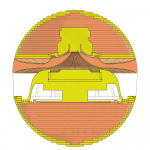The expansion from the apex to the exterior should be as smooth as possible with no cavities or hiccups along the way. The exit should match the radius of the sphere so you get the smoothest possible transition.
Highs won't be the greatest as you would need tight spacing at the driver to get good response. You need a light stiff cone with a big motor to get the highest extension. A compression driver would work much better.
Alternative is to keep the fullrange in there and add a small frame tweeter mounted in the top of the sphere to get more/better highs. This tweeter will be omni where it counts.
Tang Band 20-2240S 20mm Hi-Res Neodymium Tweeter
Highs won't be the greatest as you would need tight spacing at the driver to get good response. You need a light stiff cone with a big motor to get the highest extension. A compression driver would work much better.
Alternative is to keep the fullrange in there and add a small frame tweeter mounted in the top of the sphere to get more/better highs. This tweeter will be omni where it counts.
Tang Band 20-2240S 20mm Hi-Res Neodymium Tweeter
Last edited:
I was thinking possibly using a compression driver but need one that can crossover At around 200hz or lower. Could you suggest a few?
The Dayton limits your design flexibility with it's high inductance.
This driver would allow you to crossover wherever the compression driver needs to from 1khz down. More expensive of course. This Wavecor looks good as well but only to 400hz.
Speaker Kartesian Wom250_vPA, 8 ohm, 267 inch
Wavecor SW280WA01 11" Shallow Glass Fiber/PMI Foam Sandwich Cone Subwoofer 4 Ohm
I personally don't like to skimp on compression driver size if possible. Large format drivers generally cost quite a bit more and often have compromises above 10khz but offer cleaner output below. Especially below 2khz.
It comes down to your budget. If you use the dayton, you're looking at the B&C DCX464, BMS 4594HE, and the Celestion Axi2050. 200hz may still be too low for these depending on the slope and output requirements.
If you use the others, then something like the Eminence N314X would be a good choice.
This driver would allow you to crossover wherever the compression driver needs to from 1khz down. More expensive of course. This Wavecor looks good as well but only to 400hz.
Speaker Kartesian Wom250_vPA, 8 ohm, 267 inch
Wavecor SW280WA01 11" Shallow Glass Fiber/PMI Foam Sandwich Cone Subwoofer 4 Ohm
I personally don't like to skimp on compression driver size if possible. Large format drivers generally cost quite a bit more and often have compromises above 10khz but offer cleaner output below. Especially below 2khz.
It comes down to your budget. If you use the dayton, you're looking at the B&C DCX464, BMS 4594HE, and the Celestion Axi2050. 200hz may still be too low for these depending on the slope and output requirements.
If you use the others, then something like the Eminence N314X would be a good choice.
Last edited:
Or maybe turn the woofer 180 degrees and make the slot much smaller in order to gain volume for the woofer. Even a slot with a very small height will give an area at least the size of Sd.
Regards
Charles
Regards
Charles
It is a bit like what Samsung is doing with its round speakers. The question I have with these is how to get bot the on axis FR and the power response right. After all, we want to have a down sloping power response, and a straight on axis FR. This seems impossible to me with a speaker that radiates identically in all directions.
The question is whether the combination of a down-sloping power response combined with linear on-axis response is equally important for an omni-directional speaker as it is for ordinary speakers.
BTW: The Legend speakers are also an omni directional combination of a woofer and wideband driver, radiating via a gap around the speaker like here. The larger ones are three-way with direct radiating woofers and the midrange radiating like these ones here.
Regards
Charles
BTW: The Legend speakers are also an omni directional combination of a woofer and wideband driver, radiating via a gap around the speaker like here. The larger ones are three-way with direct radiating woofers and the midrange radiating like these ones here.
Regards
Charles
A speaker like this wouldn't work well with all material. I would still build one if I had the patience.
I think it would be highly suited to making live electric string instruments sound more interesting. Guitar and bass amps. Electric cello, violin, etc.
I think it would be highly suited to making live electric string instruments sound more interesting. Guitar and bass amps. Electric cello, violin, etc.
Last edited:
- Home
- Loudspeakers
- Multi-Way
- Orb Speaker Design Underway
